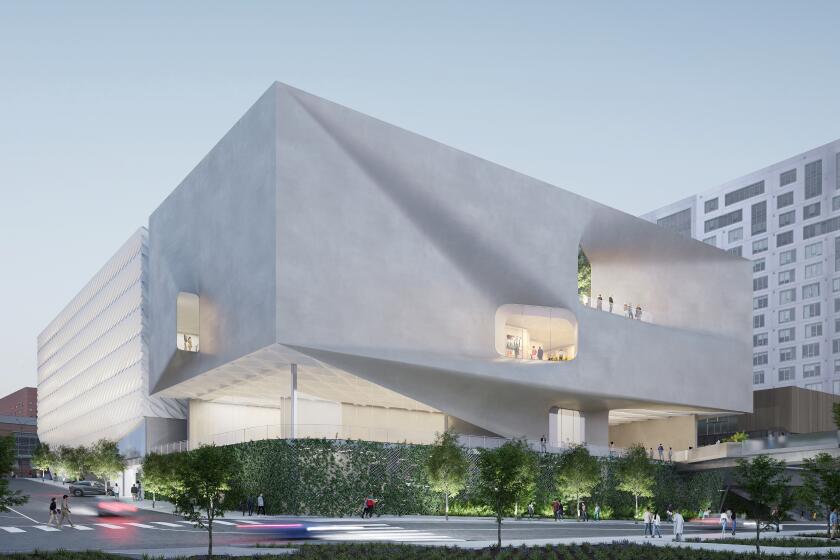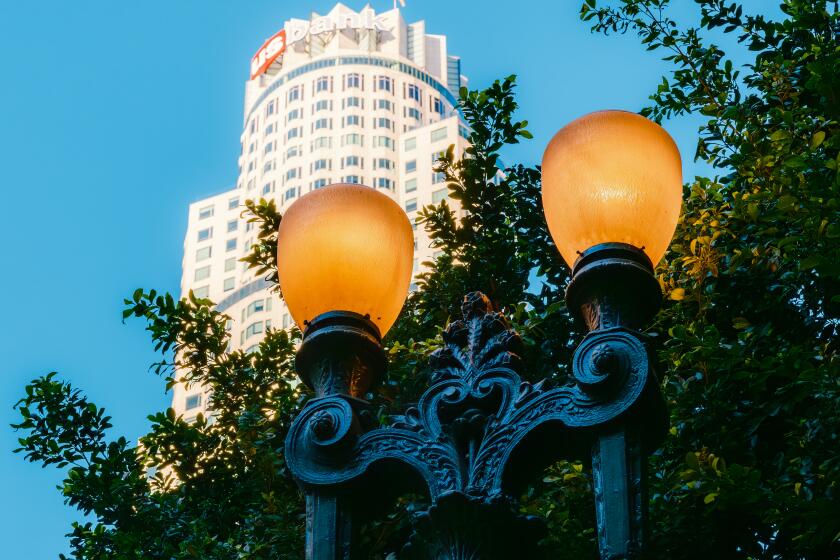Colorful translation of a 1927 classic
FROM the sidewalk, the old Spanish Revival house looks like so many others in Los Angeles: cream-colored stucco, faded red-tile roof, wrought-iron railings. But step past towering euphorbia, through the front door and into the living room, and unexpected colors shoot out as if blasted by an artist wielding a paint-ball gun. Underneath heavy wood beams are walls drenched in spearmint blue and butter yellow. A niche in the wall is painted pink. A red sun pillow rests on an orange Womb chair.
This Franklin Hills house, built in a classic style by a set designer in 1927, has been re-imagined by its latest owner, graphic designer Sean Adams. He’s concocted an unconventional mix of furnishings -- a cross between Disneyland’s Frontierland and its long-gone House of the Future -- and bright colors.
The offbeat pairing between the Old West and midcentury modern was inspired by -- no surprise in this city -- a movie. In the 1961 kid flick “The Parent Trap,” the dad of the separated twins lives in an adobe ranch house furnished with an armless sectional sofa and streamlined checkered chairs. The look is “pretty darn cool,” says Adams, 42, who saw the original version of the Disney film when he was young and bought a copy to study it when he moved into this house four years ago.
Not everyone will appreciate the blended time periods and styles, but Adams thinks that if you like something, you should have it. His aesthetic: simplicity and purity.
Over the years, the two-story house grew but stayed somewhat true to its Spanish Revival roots. A patio was enclosed to become a den with a brick fireplace. A master suite was added. A loggia was built outside the dining room doors, and a tiled pool and spa were installed.
The previous owner had a more formal style than Adams. Heavy, dark furniture was set against tan and white walls throughout most of the 2,750-square-foot house. “He did what you think you’re supposed to do if you have a house like this,” says Adams, who lives with his partner, Michael Boshnaick, a 41-year-old lawyer. The wood paneling was even painted a redundant brown.
“I wasn’t defying the laws of nature when I repainted it silver sage,” Adams jokes, adding, “I tried to stick with those boring colors, but after a week I said, ‘I can’t do this’ and I called a painter.”
But first he thought of Frida Kahlo.
ADAMS is well-versed in using punchy color and forms to get people to pay attention. He has been designing advertisements and invitations since he was in high school, and he co-founded the Beverly Hills-based graphic design firm AdamsMorioka 13 years ago.
In his print work, he’s avoided the fashionable somber colors of dingy green and grayed-down pink, and created award-winning yellow splotched stationery for Nickelodeon, rich brown cowboy covers for the Sundance Film Festival programs and other bold graphic posters, brochures and promotional pieces for clients including the Walt Disney Co. In February, he will be honored by the Los Angeles chapter of the American Institute of Graphic Arts.
Some of the bold hues he used in his home, however, weren’t taken from color swatches, but from a visit a few years ago to the late Mexican artist Kahlo’s Colonial-style house outside of Mexico City.
At the curb of Casa Azul, which is now a museum, Adams was confronted by high, cobalt blue walls that surround the grounds. Inside the house, he was bombarded with decor in the same boisterous colors the surrealist used in her paintings of watermelons and wore in self-portraits.
He also toured Mexico City to see works by architect Luis Barragan, who introduced pink and yellow to Modernist structures. Down streets and alleyways, Adams took photographs of walls painted in brilliant Mayan yellow made from local minerals.
“You can never truly match the colors of Mexico because the light is so brilliant there,” Adams says. He thinks about painting an exterior wall of his house magenta but worries about his neighbors’ reactions. With one of his guest bedrooms, however, he comes close with walls of carnation pink.
“You have to be careful with bright colors or your house can turn into a cartoon really fast,” he adds. “I don’t like a primary blue, but a blue with a touch of green. A yellow with a touch of orange gives the color complexity.”
A 3 1/2 -foot-wide wagon wheel leaning against a wall near the front step is the first sign that something’s different at this stately house. Adams jokes that as a fourth generation Nevadan it never occurred to him not to put a wagon wheel among the cactuses in his yard. “A friend was as shocked as if I’d lined the house with pixies,” he says.
In the living room, sunlight pours through the picture window, splashing a golden luster onto the hardwood floors. Adams used a bluish green on two walls. “The light that comes into the room is blue, and any color would have a blue cast, so why fight it?” he asks.
A floor lamp with orange, yellow and white spaceship-shaped shades hovers between original silk-screened posters of Disneyland’s Main Street, Frontierland and Tomorrowland. The vintage George Nelson tables are from the estate of flamboyant Reno gambling promoter Raymond I. “Pappy” Smith.
Double wood doors lead from the living room into the sunflower-yellow den. There were too many browns with the ceiling beams, paneled wall and cabinets, so the tan-painted room needed “something,” says Adams, “to keep it from being a dark cave.”
The same yellow is used in the dining room, which is on the sun-deprived north side of the house. “It too needed a little jolt to bring it up to daylight standards,” Adams says. Over the Heywood Wakefield Whalebone table is a Sputnik chandelier, its chrome arms shooting from a center ball.
Colors get a little quieter in the master bedroom. The walls are a silver sage that reminds Adams of the Great Basin sagebrush that grows wild in Nevada. “I tell everyone to paint their bedroom that color,” he says. “It’s so soothing.”
On a dresser is a model of a covered wagon. In a corner of the room hangs a turquoise-colored chandelier his grandmother gave him.
Frida meets frontier motifs and Modernism? Adams nods, adding: “Often in design you’re made to think you’re wrong if you like something that is not the current trend. Your preferences should be respected. Good design is seductive and delightful. If you like simple, bright things, more power to you.”



